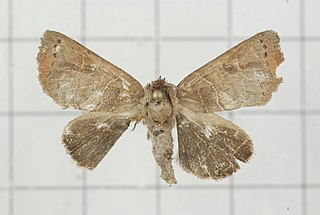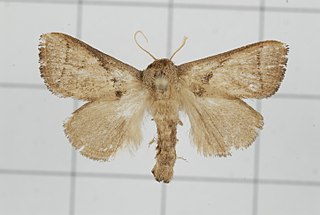Related Research Articles

Adrapsa is a genus of moths of the family Erebidae. It was erected by Francis Walker in 1859.
Themaca comparata is a moth of the family Erebidae first described by Francis Walker in 1865. It is found in India and Sri Lanka. It is sometimes placed in the genus Artaxa.
Bembina apicalis is a moth of the family Erebidae first described by Francis Walker in 1865. It is found in India and Sri Lanka.
Casama vilis is a moth of the family Erebidae first described by Francis Walker in 1865. It is found in Sri Lanka, India, Middle East, Ethiopia, Kenya and Somalia.
Euproctis semisignata is a moth of the family Erebidae first described by Francis Walker in 1865. It is found in India and Sri Lanka.

Clostera restitura is a moth of the family Notodontidae first described by Francis Walker in 1865. It is found in Oriental tropics of India, Sri Lanka, and from Hong Kong to Sundaland.
Sphetta apicalis is a moth of the family Notodontidae first described by Francis Walker in 1865. It is found in Sri Lanka.
Lygephila dorsigera is a moth of the family Erebidae first described by Francis Walker in 1865. It is found in Sri Lanka and Taiwan.
Poeta quadrinotata is a moth of the family Notodontidae first described by Francis Walker in 1865. It is found in Sri Lanka, Peninsular Malaysia, Sumatra and Borneo.
Rabila frontalis, the red bollworm, is a moth of the family Noctuidae. The species was first described by Francis Walker in 1865. It is found in India and Sri Lanka.
Adrapsa geometroides is a moth of the family Noctuidae first described by Francis Walker in 1858. It is found in Indian subregion, Sri Lanka. to Sundaland and New Guinea.

Anigraea cinctipalpis is a moth of the family Noctuidae first described by Francis Walker in 1865. It is found in Indian subregion, Sri Lanka, Malaysia, Borneo, Philippines, New Guinea and Australia.
Elusa subjecta is a moth of the family Noctuidae first described by Francis Walker in 1865. It is found in Sri Lanka, India and the Andaman Islands.
Feliniopsis opposita is a moth of the family Noctuidae first described by Francis Walker in 1865. It is found in Kenya, Somalia, Sri Lanka and India.
Thosea aperiens, the stinging caterpillar, is a moth of the family Limacodidae. The species was first described by Francis Walker in 1865. It is found in Sri Lanka and India.

Thosea cana, is a moth of the family Limacodidae first described by Francis Walker, an oriental entomologist in 1865. It is endemic to Sri Lanka, India and Taiwan.
Aroana cingalensis is a moth of the family Noctuidae first described by Francis Walker in 1866. It is found in Sri Lanka.
Pharambara micacealis is a moth of the family Thyrididae first described by Francis Walker in 1866. It is found in Sri Lanka, New Guinea and Australia.
Labanda fasciata is a moth in the family Nolidae first described by Francis Walker in 1865. It is found in Sri Lanka.
Labanda saturalis is a moth in the family Nolidae first described by Francis Walker in 1865. It is found in Indo-Australian tropics of India, Sri Lanka, and from New Guinea to the Solomon Islands.
References
- ↑ "Species Details: Badiza despecta Walker, 1865". Catalogue of Life. Retrieved 29 May 2018.
- ↑ Koçak, Ahmet Ömer; Kemal, Muhabbet (20 February 2012). "Preliminary list of the Lepidoptera of Sri Lanka". Cesa News. Centre for Entomological Studies Ankara (79): 1–57. Retrieved 29 May 2018.
- ↑ Savela, Markku. "Adrapsa despecta (Walker, 1865)". Lepidoptera and Some Other Life Forms. Retrieved 2 October 2018.